The U.S. Department of Veterans Affairs is the steward of a large collection of medical facilities that reflect the evolving care for and needs of our military’s veterans. The VA’s health care system provides diverse care through approximately 170 VA medical centers and outpatient clinics across the country, serving millions of veterans each year. Pennsylvania is home to a wide range of federal facilities offering medical services for veterans.
Western Pennsylvania’s Butler Veterans Administration Hospital recently joined two other current VA hospital properties in Pennsylvania listed in the National Register of Historic Places, recognizing its important and unique role in caring for military veterans.
Brief History of US Veteran’s Hospitals
Philadelphia’s Biddle Hall, completed in 1833, represents the earliest era of care provided to military veterans by the federal government. It can be considered the U.S.’s first federal veterans’ retirement home and, until 1868, also housed a naval hospital, one of the earliest regional naval hospitals in the country. Over the 19th century, other buildings were added to the Biddle Hall campus and the area called the U.S. Naval Asylum (PA-SHARE Resource # 1972RE00364).
The importance of early resources such as Biddle Hall and the Naval Asylum, which was designated a National Historic Landmark in 1976, have been recognized for decades. Facilities built later, especially during the 20th century, have not always been as well understood or appreciated.
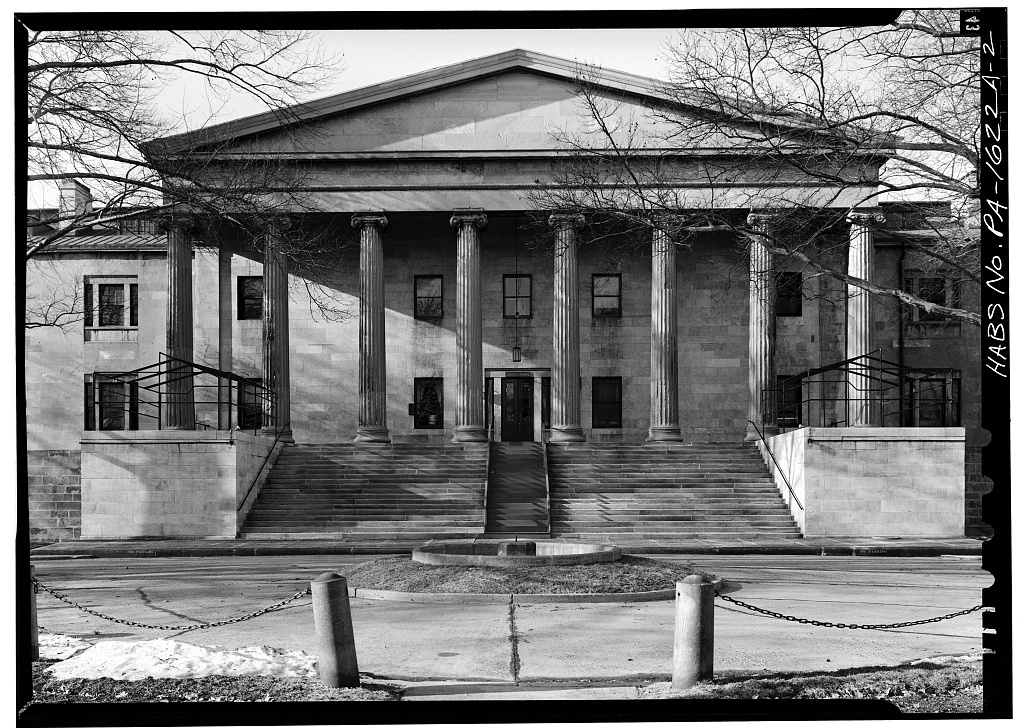
Resources such as the Naval Asylum were limited until the period following the Civil War, which brought the construction of the National Homes for Disabled Volunteer Soldiers. Starting in 1866, these facilities provided some medical care and residential facilities for Union Veterans. Based on a military model and featuring parade grounds, barracks, hospitals, and cemeteries, these facilities, many of which are still part of the VA’s hospital network, are referred to by the VA as the “First Generation” of veterans’ hospitals.
Following U.S. participation in WW I, veteran care shifted from providing long-term housing to include general and specialized healthcare through the construction of hospitals that emphasized rehabilitative care and a return to civilian life for those recent veterans.
Called “Second Generation” veterans’ hospitals, generally built between 1919 and 1950, these were characterized by sprawling campuses on rural sites, with low-rise buildings built in revival styles (such as Colonial Revival or Classical Revival), and facilities constructed based on the primary type of patient to be cared for, such as veterans in need of neuropsychiatric care or ones with tuberculosis or other lung damage.
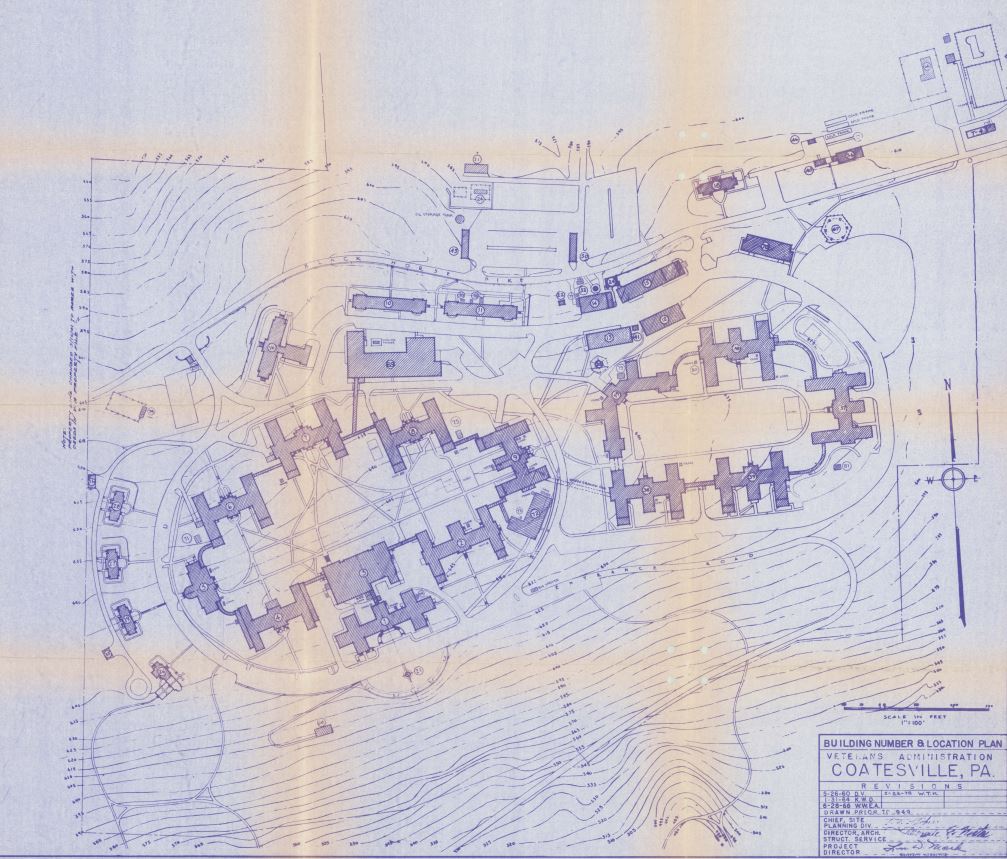
In response to the volume of veterans returning after serving the U.S. in WW II, with slightly different needs, the VA initiated a nationwide construction campaign of new hospitals modeled on the latest in modern healthcare trends.
“Third Generation” veterans’ hospitals, generally built between 1946 and 1958, were constructed by the VA to provide modern healthcare to the growing population of recent veterans following WW II. The nationwide construction campaign generally resulted in skyscraper-like main hospital buildings (including the VA facilities in Pittsburgh and Philadelphia) that consolidated patient care in a single facility.
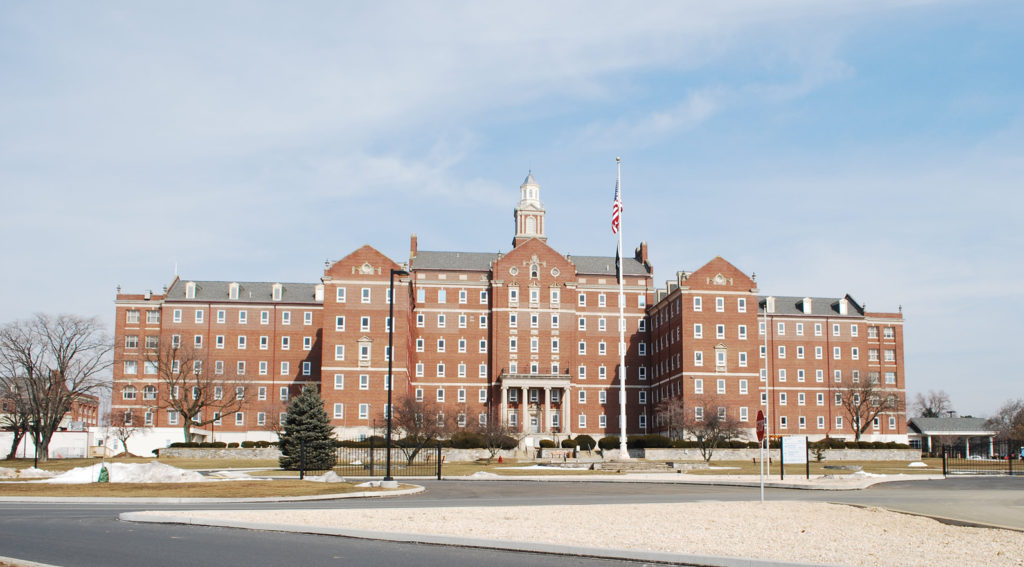
In order to meet the demands for veterans’ healthcare needs while these newer facilities were under development, the VA often turned to facilities already in existence to provide medical services to veterans returning from recent service.
These campuses represented the more typical Third Generation facilities, with urban locations, often near medical schools, and feature central skyscraper-type main hospital buildings with support facilities clustered together. They reflect modern architectural styles and rejected the revival-style architecture favored by the Second Generation VA hospitals.
Listing VA Hospitals in the National Register
For almost 20 years, the VA has been undertaking a concerted effort of nationwide survey and analysis to evaluate its hospitals and medical centers for National Register eligibility, creating context statements to put the ever-evolving facilities into perspective.
To date, the VA has commissioned two historic contexts for VA hospitals in the form of Multiple Property Documentation Forms (MPDFs). These MPDFs are nationwide in scope and provide history, nationwide context, and registration requirements to assist in the evaluation of VA hospitals for listing in the National Register:
- United States Second Generation Veterans Hospitals (2011). This MPDF covers VA hospitals built between 1919 and 1950.
- United States Third Generation Veterans Hospitals (2018). This MPDF covers VA hospitals built between 1946 and 1958.
Three of Pennsylvania’s VA hospitals are listed in the National Register under these contexts. The Lebanon Veterans Administration Hospital Historic District (PA-SHARE Resource #1980RE00415, listed in 2013) and Coatesville Veterans Administration Hospital (PA-SHARE Resource #1981RE00731, listed in 2013) are listed under the Second Generation hospitals context. The Butler Veterans Administration Hospital (PA-SHARE Resource #2004RE06024, listed in 2022) is listed for its significance as a Third Generation hospital.
Butler VA Hospital
The facility that would become the Butler VA Hospital (PA-SHARE Resource #2004RE06024) has a bit more of a convoluted history than most other Third Generation hospitals.
The Butler VA Hospital was originally built in 1940 as the Western Pennsylvania Tuberculosis Sanitorium. In 1937, the Commonwealth of Pennsylvania announced that a new facility to care for tuberculosis (TB) patients would be built in western Pennsylvania and a 100-acre area northwest of the City of Butler in Butler County was selected as the site. Pittsburgh architect Edward B. Lee designed the sanatorium, which included one large main building (with a wing to accommodate children), separate quarters for nurses and employees, a laundry, garage, and various other support buildings.
Because of state budget deficits and disagreements over the need for the facility, the sanitorium was never occupied. After two years, in December 1942, the commonwealth leased the Western Pennsylvania Tuberculosis Sanitorium to the U.S. Army. It was renamed the Deshon General Hospital.
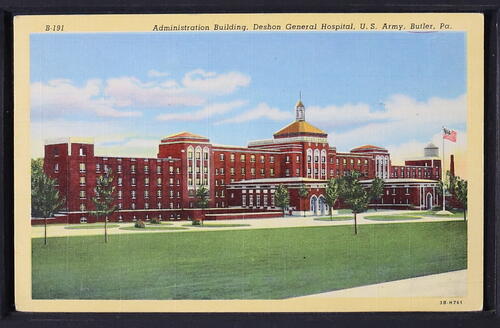
The Army and Navy faced the same problem VA would confront at the end of the war: insufficient facilities to provide healthcare for their service members. At the start of World War II, the U.S. Army needed to expand its number of available hospital beds stateside. By May of 1942, a “Directive for Wartime Construction” established the policy of converting civilian hospitals to Army use and building new facilities where existing facilities were not feasible.
The unoccupied Western Pennsylvania Tuberculosis Sanitorium was a perfect fit for the Army’s needs. The Army added patient wards and recreation buildings directly to the south of the main (original) hospital building. The low-rise, simple brick buildings were neatly organized in rows connected by covered walkways. The capacity swelled from 500 to 1,000 beds.
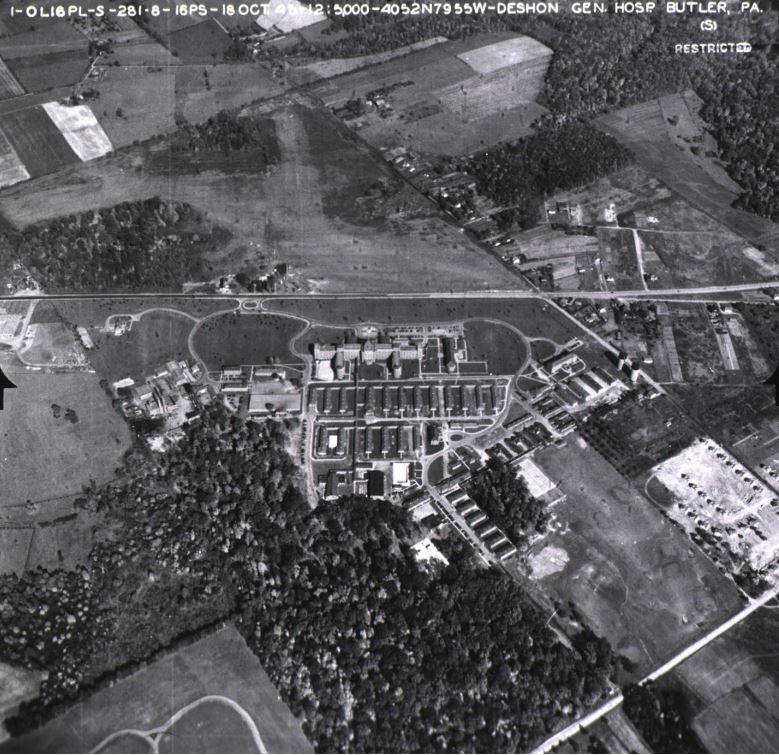
Following the end of World War II, the Army told Pennsylvania it would no longer need Deshon General Hospital after operating it for only four years. At the same time the Army was interested in decommissioning Deshon, the VA was exploring options to better serve western Pennsylvania’s veterans.
The VA identified Deshon as good interim option to provide care to veterans while two new Third Generation facilities were built in the Pittsburgh area. The VA ultimately constructed six hospitals in Pennsylvania as part of this post-WW II campaign “Second Generation” building campaign, in Altoona, Erie, Philadelphia, Pittsburgh (University Drive and Highland Drive locations), and Wilkes-Barre.
In May 1946, Deshon was transferred to the VA and the name changed to Butler Veterans Administration Hospital. With Butler, the VA acquired an existing facility that was only six years old, designed specifically for the care of tuberculosis patients—the very use the VA needed at the time. The VA elected to retain the existing buildings, both from the tuberculosis sanatorium and Army general hospital eras.

Despite price negotiations that weren’t officially resolved in 1952, the VA had been occupying the property starting July 1, 1946; by 1948, the Butler VA Hospital operated with 521 beds for TB patients, and 443 for general medical and surgical patients. The hospital was formally converted to a TB hospital in 1952, returning to the campus’ original intended use.
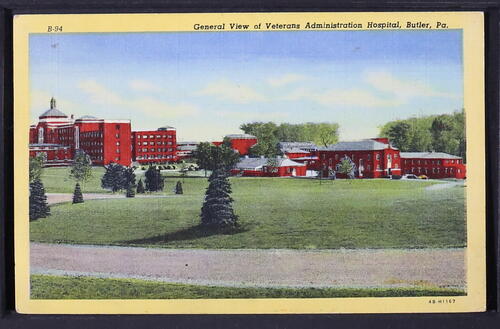
By the time the VA acquired Butler, it had an established history of caring for veterans suffering from TB. During World War II, the VA grew concerned that the military operations of the war would not only lead to an increased occurrence of TB in the veteran population, but also would spark an increase in the civilian population, as cases were already on the rise in major US cities.
Following World War II, the VA developed a TB research program and Butler VA Hospital was an important part of TB research and treatment. Throughout the late 1940s and 1950s, researchers and doctors at Butler conducted tests of new drugs for strains of TB that were resistant to streptomycin and as well as the efficacy of drugs paired with streptomycin. The Butler VA also initiated programs to assist with the mental and emotional wellbeing of their TB patients, such as vocational therapy and patient education to increase cooperation and prevent early termination of TB treatment.
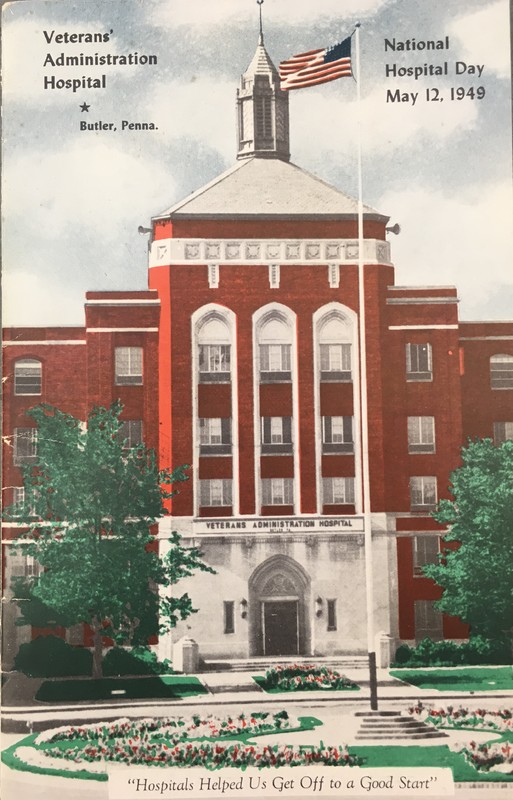
In the 1960s, as the VA’s healthcare transitioned away from TB treatment at Butler. Throughout the next several decades, the VA continued to operate the facility with programmatic changes to veteran care such as expanding general medical services, the introduction of a dental program, a nursing home unit, increasing rehabilitation programs and, more recently, an overall shift to outpatient care
The Butler VA Hospital was listed in the National Register on May 27, 2022, for its important role in providing treatment to Pennsylvania veterans following World War II and for the design of portions of the campus. The property represents a critical point in the VA’s history, when existing facilities served temporary stop gap measures to meet increasing needs.
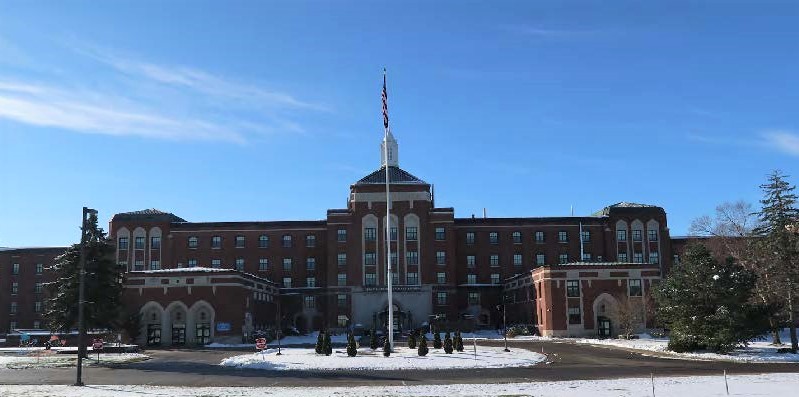
The campus was listed under the United States Third Generation of Veterans Hospitals MPDF. During their survey of Third Generation hospitals, the VA determined the Butler hospital to be an important example of the “Third Party Hospital” subtype of the Transitional Hospitals category, and worthy of recognition.
To learn more about the evolution of veterans’ care in the U.S., you can visit VA History Office website. You can also read the detailed histories provided in the Multiple Property Documentation Forms linked in this post. The forms and the National Register nominations for the Naval Asylum and the Coatesville, Butler, and Lebanon VA hospitals are all also available via PA-SHARE and can be found searching by name or PA-SHARE Resource number.
Comment Policy
PHMC welcomes and encourages topic-related comments on this blog. PHMC reserves the right to remove comments that in PHMC’s discretion do not follow participation guidelines.
Commenters and Comments shall be related to the blog post topic and respectful of others who use this site.
Commenters and Comments shall not: use language that is offensive, inflammatory or provocative (this includes, but is not limited to, using profanity, obscene, or vulgar comments); disparage other commenters or people; condone illegal activity; identify the location of known or suspected archeological sites; post personal information in comments such as addresses, phone numbers, e-mail addresses or other contact details, which may relate to you or other individuals; impersonate or falsely claim to represent a person or an organization; make any commercial endorsement or promotion of any product, service or publication.
If you would like to comment on other topics not related to this blog post but related to PHMC, please fill out the PHMC Contact Us Form.
I really found this article interesting. Thank you very much.
As a native of Butler whose great uncle was housed at the VA for most of his adult life due to an injury while serving his country, I often visited him with his sister and her husband, my maternal grandparents, and am thrilled to see this icon of my hometown’s historic architectural landscape receive the recognition it deserves. Thank you April for the fascinating summary of its history, much of which I was not aware of, despite growing up in Butler. Hopefully this recognition will help contribute to the VA’s continued maintenance and preservation of this important landmark.
Looking for a register for student nurses and nurses from 1944 and 1947. Wife’s mother worked there `